Vegetarian and Vegan Food in Greece: Your Insider’s 2024 Survival Guide
Vegan food in Greece? Vegetarian food in Greece? Both are far easier to find than you might imagine.
Finding vegetarian and vegan food in Greece probably sounds like it’s going to be a difficult task. After all, meat is a huge part of Greek food culture.
However, you can find vegan food here almost everywhere. Not to mention, there is lots of variety too!
Don’t think that being veggie/vegan in Greece means having to order the same boring salads every day. That is simply not the case.
Ordering Vegetarian and Vegan Food in Greece

It is worth noting that while there are plenty of vegetarian and vegan food options in Greece, you really ought to have an idea of what kind of dishes are vegetarian and vegan friendly before you set off on your Greece itinerary.
Greece is a country that consumes a lot of meat. This is a fact that you’re probably well aware of. While the concept of vegetarianism is understood, veganism is something quite new here.
Things are progressing here slowly but surely. However, if you wander into most tavernas in Greek islands like Paxos, Skopelos, or any other Greek paradise, and ask for a run-through of their Greek vegan food options, you are likely to be met with blank stares.
That’s why it pays to do a little research beforehand. Familiarise yourself with Greek dishes before your trip and what their ingredients are.
Identifying Vegetarian and Vegan Food on Menus in Greece
Many Greek taverna menus have vegetarian sections. Alternatively, they indicate which options are vegetarian-friendly by putting a little “V” symbol next to the dishes. Identifying vegan food in Greece is a little trickier.
There is no Greek word for vegan. As such, the word “vegan” (in English) is the best way to get your point across to locals.
This is written on menus as βίγκαν or βέγκαν in Greek. However, you really, if ever see this label even if things are vegan friendly. Perhaps only at a handful of mindful restaurants in major Greek cities.
You Need to Double Check Everything
Sometimes things get lost in translation when trying to order Greek vegan food. Waiters may not know all of the specific ingredients that go into a dish.
They may confirm that it is vegan-friendly when the reality is that it is not.
There is also some confusion between being pescatarian, vegetarian, and vegan. Several vegan-friendly Greek dishes are outlined in this guide.
Some dishes may be labelled as vegan. Yet the specific restaurant adds cheese or some other “added-extra” animal product to the traditional recipe.
Chicken stock, beef stock, or fish sauce may be used in certain cooking bases. The restaurant staff may not fully understand the concept of veganism.
So, they may shrug off that there is a little stock/cheese/cream/etc in the dish and reassure you that it’s fine when it isn’t.
For this reason, you should always ask the waiter to confirm that no animal products are used in the cooking. If he/she seems unsure, request that they confirm with the chef.
Vegetarian and Vegan Foods in Greece
A selection of great choice vegetarian and vegan foods to try in Greece is detailed below. This is not exhaustive. The list will be updated periodically.
Greek Fava (Yellow Split Pea Puree)
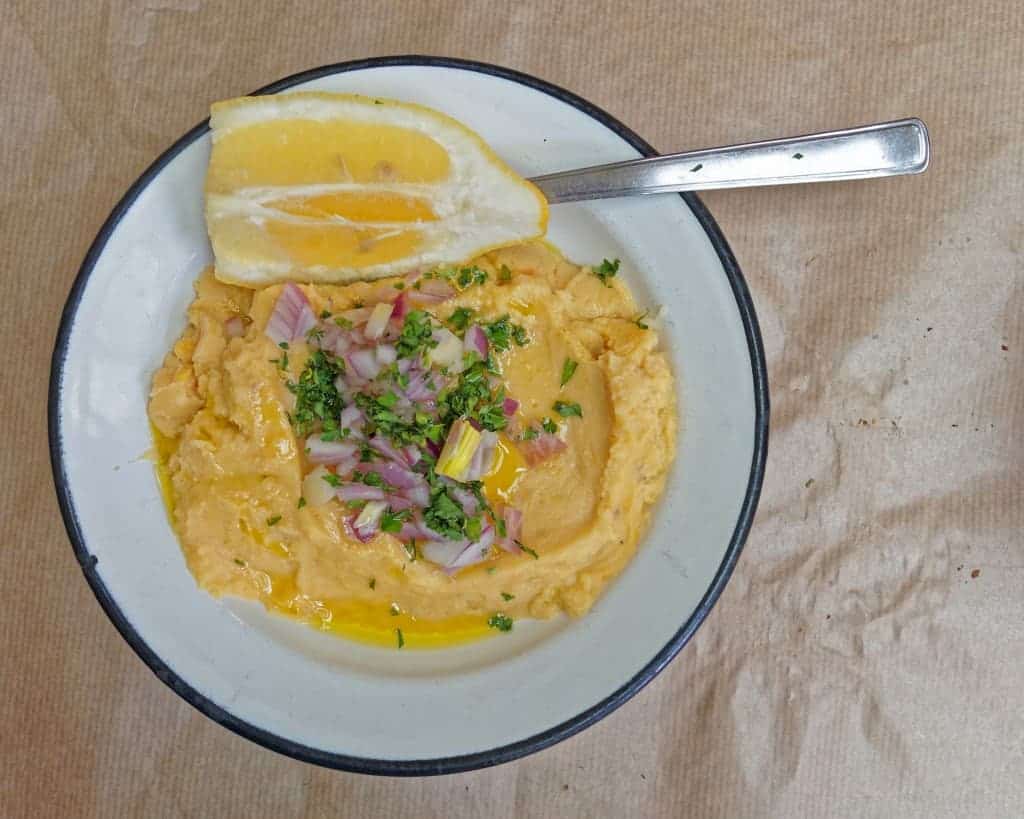
Fava bean puree is a favourite dish in Greece. It comes from beautiful Santorini. However, you will find it all over the country.
This dish is simple. Yellow fava beans are pureed and then red onions, garlic, olive oil, lemon juice, and thyme are added. Some restaurants add other goodies too, like capers.
You usually eat this with homemade bread that the restaurants make themselves. This is one of the most popular Greek meze dishes so you will see it everywhere.
Vegan-friendly? Yes but check with the restaurant about their bread.
Fasolakia (Greek Braised Green Beans)
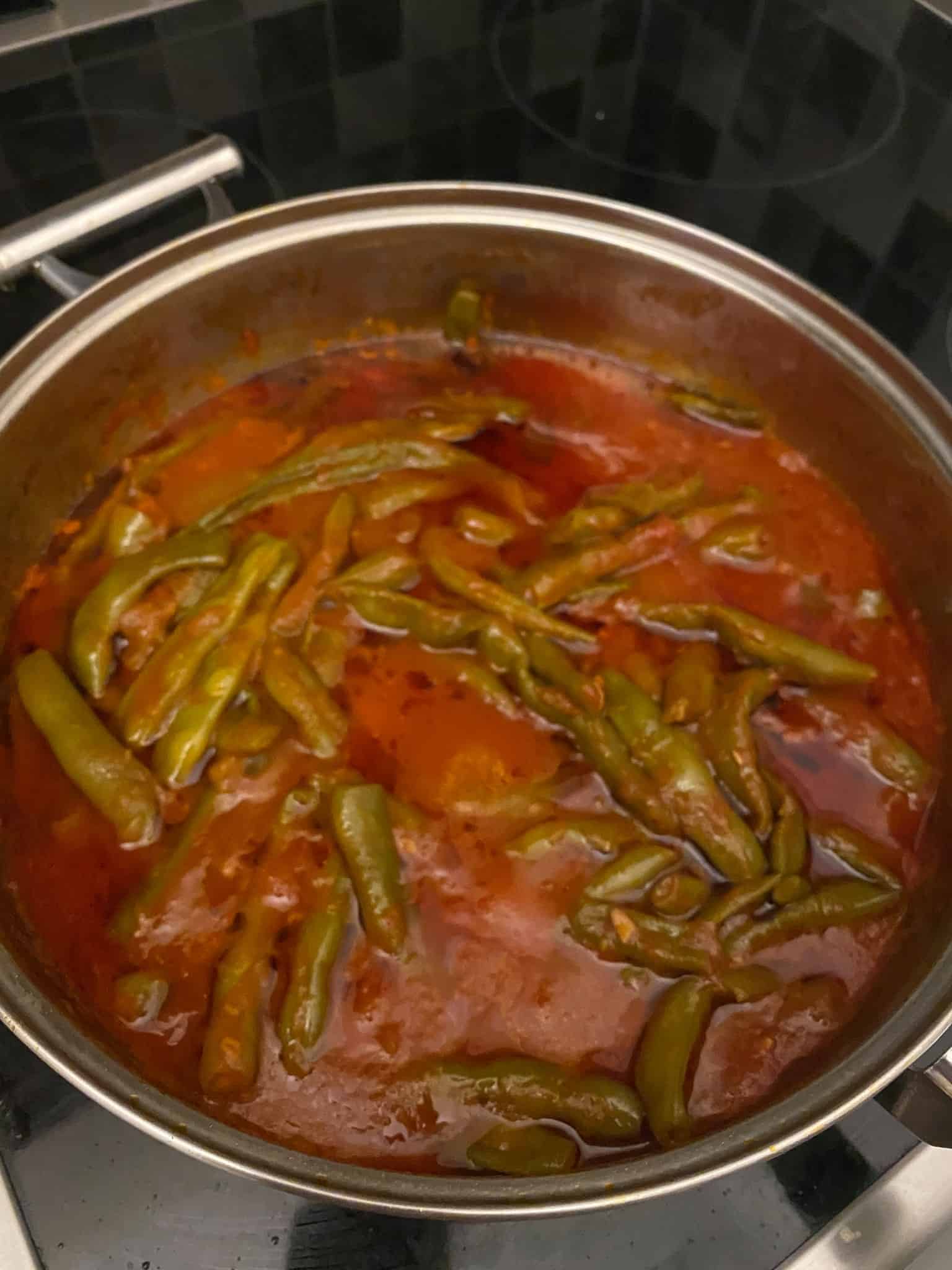
Fasolakia is one of the most flavourful dishes in Greece. Discovering it will change your life!
Fasolakia is Greek green beans cooked until they are incredibly soft and have a texture that resembles tagliatelle. The beans are served in a sauce made from pureed tomatoes, olive oil, onions, garlic, and oregano.
Portions are huge in Greece. Although fasolakia is technically a side dish, you could easily have it as a main.
Some restaurants make their fasolakia in different ways and add potatoes or other veggies inside. Greeks will often eat fasolakia with feta cheese sprinkled on the top.
In restaurants, feta portions are served as a separate meze. However, if you are vegan it is worth checking with your server that they are not going to top your dish with cheese.
Vegan-friendly? Yes, and gluten-free!
Aginares Ala Polita
Aginares Ala Polita is a delicious Greek vegan dish that you can enjoy when artichokes are in season in Greece. The dish is prepared by sauteeing onions, leeks, spring onions, peas, potatoes, artichokes and carrots.
It is then seasoned with fresh squeezed lemon juice and fennel. The months of March to June are artichoke season in Greece, and this dish is likely to be more readily available at this time.
Vegan-friendly? Typically, yes. However, you should confirm with the waiter and check that egg-lemon sauce has not been used in place of simple lemon juice.
Melitzanosalata
Melitzanosalata is more of a condiment than a dish. However, you may wish to order it for your table if you find yourself at a meze place.
Melitzanosalata is made by pureeing roasted eggplants and adding red pepper, garlic, apple cider vinegar, olive oil, spring onion and parsley. It makes a great accompaniment for either bread or vegetable dishes (e.g. zucchini fritters).
Vegan-friendly? Yes
Prasorizo
Prasorizo is a delicious and creamy rice dish prepared with caramelised leeks, dill, and tomato paste. It is enjoyed throughout the year in Greece.
The dish is mainly prepared by Greek yiayias at home, and is less commonly seen on taverna menus. However, you are more likely to find it at restaurants during nisteia. This is the fasting period whereby Greeks do not eat any animal products in the lead up to Easter.
Vegan-friendly? Yes
Lahanorizo
Lahanorizo, like prasorizo, is a popular one-pot Greek rice dish. This is essentially just cabbage rice.
Despite being so simple, lahanorizo is creamy, comforting, and flavourful. Some modern variations of the dish add ground beef or cheese to the recipe.
As such, be sure to check the ingredients with your waiter prior to ordering. Traditional lahanorizo should not contain animal products.
Vegan-friendly? Yes
Halvas
Halvas is a popular Greek dessert that is made from tahini and has a dry, crumbly texture. You may have sampled halvas before if you have travelled in the Middle East or in Turkey where it is also enjoyed.
The consistency of halvas can seem a little strange at first and this certainly isn’t for everyone. You will find halvas sold at the traditional markets close to Evripidou Street in Athens. It is also sometimes served as a complimentary treat after a meal in many tavernas.
Vegan-friendly? Yes
Bamies Laderes
Bamies Laderes is a traditional Greek stew prepared with okra. The okra is slow-cooked in tomato sauce until it soaks up all of the flavours and literally melts in your mouth.
Vegan-friendly? Yes. However, this is often topped with feta cheese so be sure to ask your server not to add cheese.
Pita Oikologiki
Pita gyros and souvlakis are among the most popular Greek street foods out there. If you do not eat meat and yet you find yourself in a souvlaki joint with your friends and travel companions, you can order yourself a Pita Oikologiki.
This is a vegetarian pita filled with potatoes, vegetables, and tomato sauce.
Vegan-friendly? Yes. However, ask them not to add tzatziki as this contains yoghurt.
Dakos
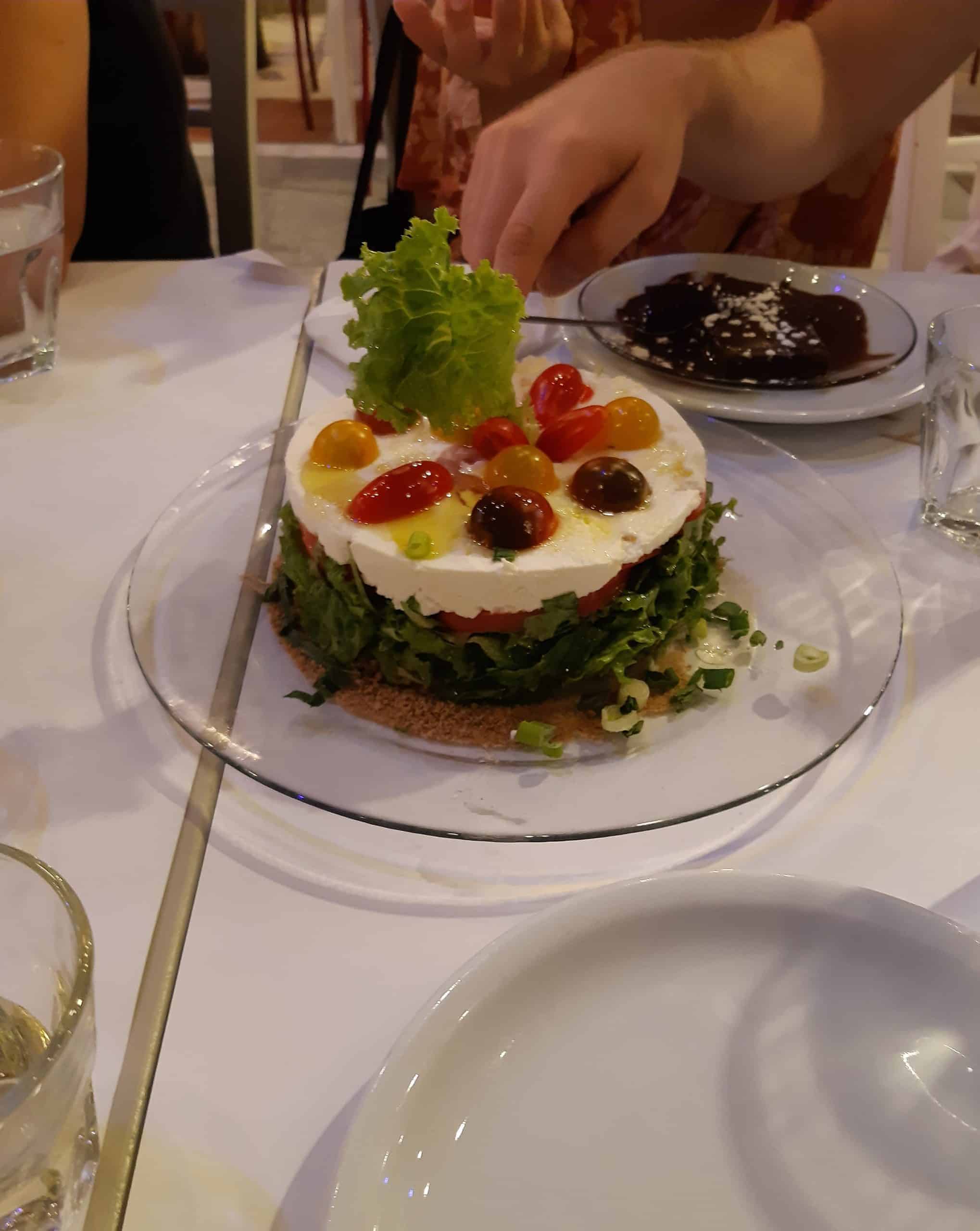
Dakos is a really delicious salad that is presented like a cake – a salad cake! It is a Cretan dish so it’s not a super common thing to find in mainland Greece/outside of Crete. However, some restaurants do prepare their versions of it.
Unfortunately, Dakos contains cheese so it isn’t vegan-friendly. The base layer of this salad is made up of barley rusks.
It is then topped with a generous serving of soft cheese. This is commonly Cretan mizithra.
Feta is sometimes used if you’re outside of Crete. Cherry tomatoes and black olives decorate the top of the salad.
Then, the whole thing is drizzled with olive oil. The idea of Dakos is to share it between two or more people.
Vegan-friendly? No. This dish contains cheese.
Lentil Soup (Fakes)
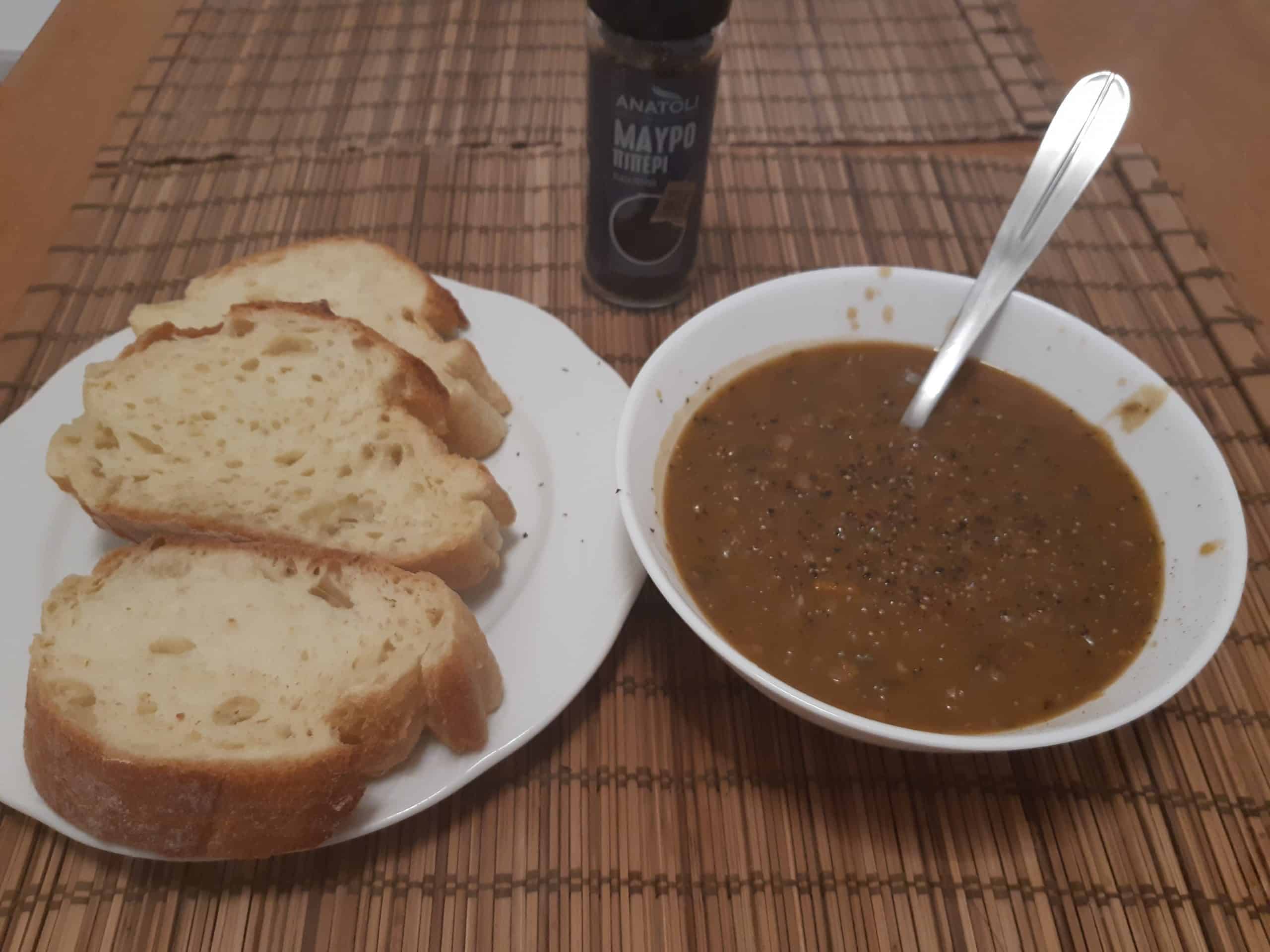
Greek lentil soup (fakes) is a popular starter dish across Greece. The soup is one of the tastiest options for vegan food in Greece. It is very similar to lentil soups that you may have sampled in Turkey or the Middle East.
If you travel to Greece during the winter months, there is nothing cosier than a steaming hot bowl of fakes. Typically, this is served with a drizzle of olive oil and a dash of vinegar. Huge portions of lentil soup in Greece typically cost no more than €4-5.
Vegan-friendly? Yes, and gluten-free!
Arakas
Arakas is a green pea and tomato stew. It’s a hearty and warming dish to enjoy during winter in Greece. Between Autumn and Spring, you will often see it on the menus at mageirios (Greek canteens).
Vegan-friendly? Yes
Chickpea Soup (Revithia)
Delicious, creamy, filling, and golden, Greek chickpea soup (revithia) is a classic Greek winter dish. You can find it here all year round.
However, whether you want to eat hot soup during 40-degree heat in the height of summer is another matter! You can have it as a starter at a taverna or as a main.
Revithia is prepared with chickpeas, chopped celery, carrots, sage, and thyme. It is incredibly simple, yet so hearty and filling!
Vegan-friendly? Yes, and gluten-free!
Spanakopita
Spanakopita is essentially the national pastry of Greece. This light, fluffy filo pastry is filled with delicious, crumbly feta cheese and spinach.
You can buy huge slices of spanakopita (enough for 2 portions essentially) at most Greek bakeries for €1.70. Greek pastries are a huge part of the food culture here.
If you opt to stay in self-catered accommodation, you can enjoy your spanakopita with Greek yogurt and salad for a lovely light lunch. Spanakopita is also commonly served as part of a continental breakfast at a lot of hotels in Greece.
Vegan-friendly? No. Spanakopita contains feta cheese
Greek Salad
When you eat out in Greece, people pretty much always order a salad for the table to accompany their main dishes. Menus at restaurants and tavernas usually detail a range of different salad dishes, but Greek salads (“horiatiki”) is the best known.
Did you know that there is not actually any lettuce contained in Greek salads? The dish is made from fresh Greek cherry tomatoes, cucumbers, onions, and black olives.
It is then seasoned with sprinklings of salt and oregano before a dash of olive oil is added. Horiatiki usually contains feta cheese, but vegan diners can request that this is omitted.
Vegan-friendly? No, the salad contains feta cheese. However, you can request that this is not added.
Tomato Keftedes
Tomatokeftedes are a type of vegetable fritter that originates from Santorini. This is a popular appetiser in the Cyclades, but you will see tomato keftedes also served at a lot of tavernas in mainland Greece as well.
The dish is made by pureeing tomatoes, and then frying them in olive oil. You can enjoy tomato keftedes alone, or dip them in tzatziki.
Vegan-friendly? Yes
Kolokithokeftedes
There are a few variations of the Santorini tomato keftedes, each made with different vegetables. One popular version of this dish is kolokithokeftedes.
These are fried zucchini fritters commonly prepared with feta and herbs. Sometimes you can also find tiganita kolokithakia (Zucchini chips) but these are less common.
Vegan-friendly? Maybe. Check with the specific taverna to see if they are preparing the dish with feta cheese.
Black-Eyed Pea Salad
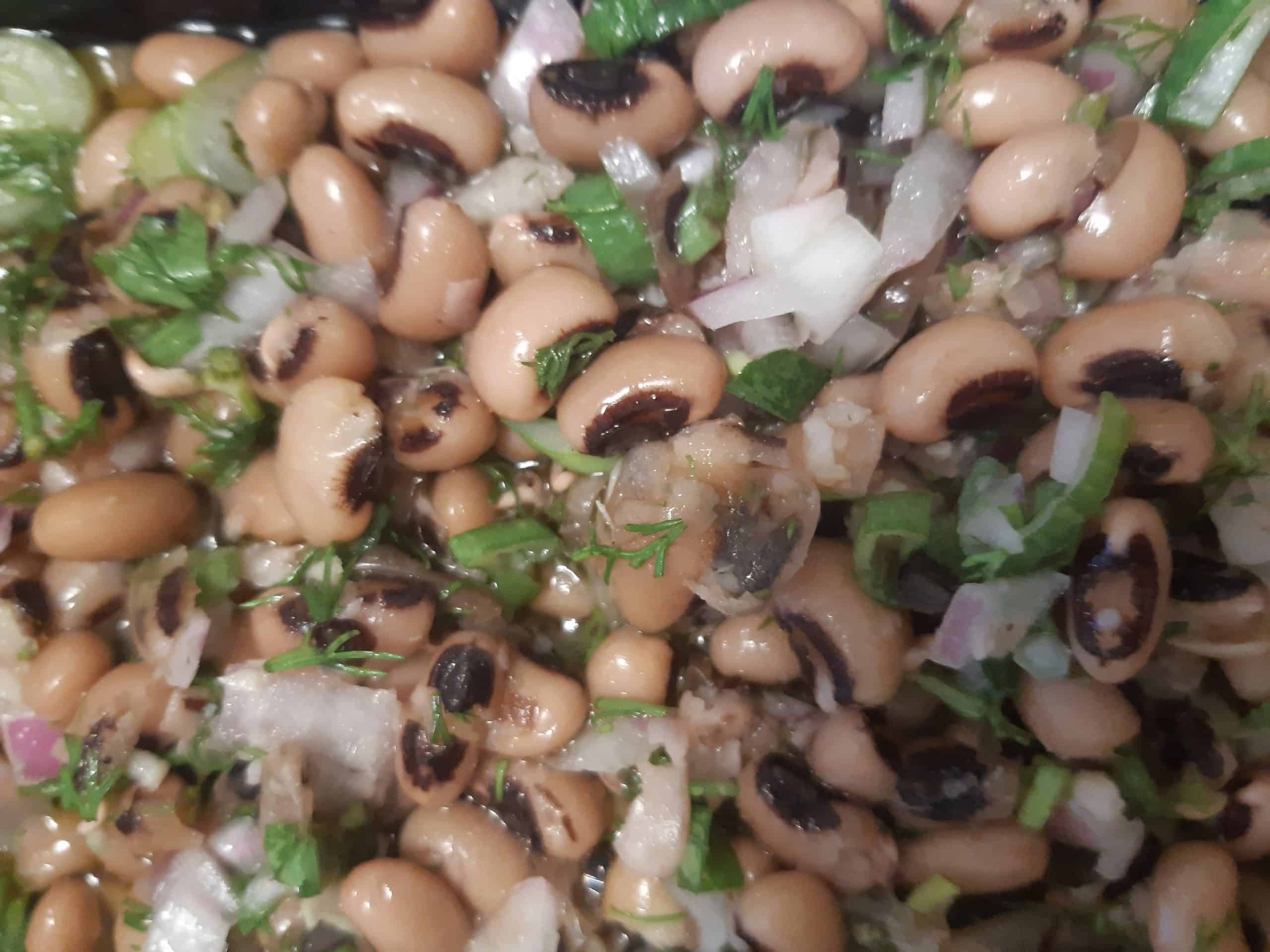
The Greek black-eyed pea salad is refreshing and tasty. This is another very popular dish that you will find in most tavernas and meze places.
The peas are boiled and served with leeks, carrots, tomatoes, spring onions, mint, and parsley. The dish usually tastes quite minty. Olive oil is then drizzled over the top.
Vegan-friendly? Yes, and gluten-free!
Bean Soup (Fasolada)
Fasolada soup is often referred to as being the “national dish of the Greeks”. However, it’s similar to a lot of other Mediterranean dishes.
If you’ve spent a lot of time travelling across Europe, chances are that you’ve had something similar to this before. It is comparable to Spanish “fabada” or Italian “fagiolata”.
This dish is prepared using Greek white/butter beans. Next, vegetables are added (commonly onion and celery), extra virgin Greek olive oil, and balsamic vinegar.
Vegan-friendly? Yes
Vegetarian “Imam”
Vegetarian Imam is a popular veggie dish here in Greece. Its origins are actually Turkish.
In Turkish, the dish is called Imam bayildi. Imam consists of aubergine stuffed with tomatoes, garlic, and spices.
This is often cooked in an oven in Greece, However sometimes it is BBQ’d or cooked over hot coals creating a wonderful smoked flavour.
A lot of Greek dishes have Turkish origins. This is due to the Ottoman occupation of the country that spanned over several centuries and left a significant impact on Greece’s cuisine.
Legend has it that when this dish was first created, it was so delicious that the Imam that sampled it fainted! Imam bayildi literally translates to “the Imam fainted”.
Note: Be sure to clearly specify that you want vegetarian Imam. The non-vegetarian version of this dish is very popular and is prepared with lamb.
Vegan-friendly? Yes
Spanakorizo
Spanakorizo is a simple dish comprised of white rice prepared with spinach. It is regarded as being the Greek answer to pilaf.
Generous amounts of fresh lemon juice are squeezed over the top of the rice (you’ll be given your own lemons). Then, virgin olive oil is drizzled on top of it.
This dish is more commonly found in the country and in more rural areas. However, you will sometimes find it at tavernas and canteens.
Vegan-friendly? Yes
Gemista
Gemista is the Greek answer to risotto. It consists of fresh vegetables stuffed with fluffy white rice, vegetables, and spices.
Countless variations of gemitsa (also called “yemitsa”) are available. Commonly, this is made with tomatoes or bell peppers.
Vegan-friendly? Maybe. Check the specific recipe to ensure that cheese is not added.
Dolmades
Dolmades are a classic Greek dish comprised of stuffed vine leaves. You might have sampled a variation of this dish before.
Dolmades are the same as “dolmas” found across Turkey, Central Asia, and the Middle East. They are served in both vegetarian and meat-filled forms so be sure to double-check what you order.
The vegetarian version of dolmas is often stuffed with white rice, onions, nuts, and dill. Fresh lemons are squeezed over the top for taste.
Vegan-friendly? Yes
Gigantes Plaki
Gigantes Plaki are baked beans served Greek style. If you’re grossed out by the concept of the British-style baked beans, don’t use that as a basis for judging Greek baked beans.
Gigantes Plaki are infinitely more tasty and fresh. “Gigantes” means “giant” in Greek – aka the dish translates to “giant beans”
Large white Greek beans are cooked in a delicious, tomato sauce with cinnamon and oregano seasonings. You can order this as part of a meze, or enjoy the beans drizzled over homemade sourdough bread.
Vegan-friendly? Yes
Lahanosalata
Lahanosalata is essentially Greek coleslaw. You will often find that it is served as a side dish at tavernas and it is especially popular during the winter months. This is on account of the seasonal, autumnal veggies that are used in the dish.
To make lahanosalata, finely shredded carrot and cabbage are flavoured with fresh fennel, extra virgin olive oil, and lemon juice. Like most Greek dishes, it is incredibly simple yet tasty.
Vegan-friendly? Yes
Skordalia
Skordalia is more of a condiment or sauce than a main dish. However, it is worth mentioning here as it is incredibly tasty and easily becomes a nice addition to a light lunch in Greece.
Potatoes are pureed and then mixed with crushed garlic, olive oil, and white wine vinegar to form skordalia. This thick and tasty sauce is then enjoyed over homemade bread or sourdough.
Vegan-friendly? Yes
Briám
Briam are Greek oven-baked vegetables that are seasoned and cooked to perfection. You can easily enjoy a plate of briam for one person and enjoy it as a main, or order it for the table at Athens restaurants as a side dish.
Zucchini, aubergine, potatoes, and tomatoes are flavoured with aromatic herbs, drizzled with olive oil. Then they are baked in the oven.
Vegan-friendly? Yes
Patzaria
Patzaria is quite simply, roasted beetroot. This another popular meze dish here in Greece.
Order patzaria in accompaniment of 4-5 other small dishes. The “Greek way” to eat patzaria is to pair it with Skordalia garlic puree.
Vegan-friendly? Yes
Lemon Roasted Potatoes
Lemon roasted potatoes are a staple at the Greek dinner table on Sundays. They are also commonly served as a side dish at tavernas.
Don’t underestimate how much more tasty potatoes become with just the simple addition of lemon juice and oregano. You could enjoy them as part of a meze with other vegetable dishes and a small salad.
Vegan-friendly? Yes
Tzatziki
Tzatziki is a staple Greek condiment. Go over to any Greek friend’s house and you will likely find huge tubs of homemade tzatziki in their fridge.
Tzatziki is a Greek yogurt that is flavoured by adding chopped cucumbers, olive oil, salt, and garlic. Depending on the specific recipe, the condiment is also sometimes seasoned with vinegar or herbs.
Vegan-friendly? No
Vrasta
Vrasta (also referred to as “Horta Vrasta”) are simply boiled greens. These are usually dandelion greens or spinach, made tasty with the addition of salt and lemon juice to taste.
Vegan-friendly? Yes
Advice for Eating Vegetarian and Vegan in Greece
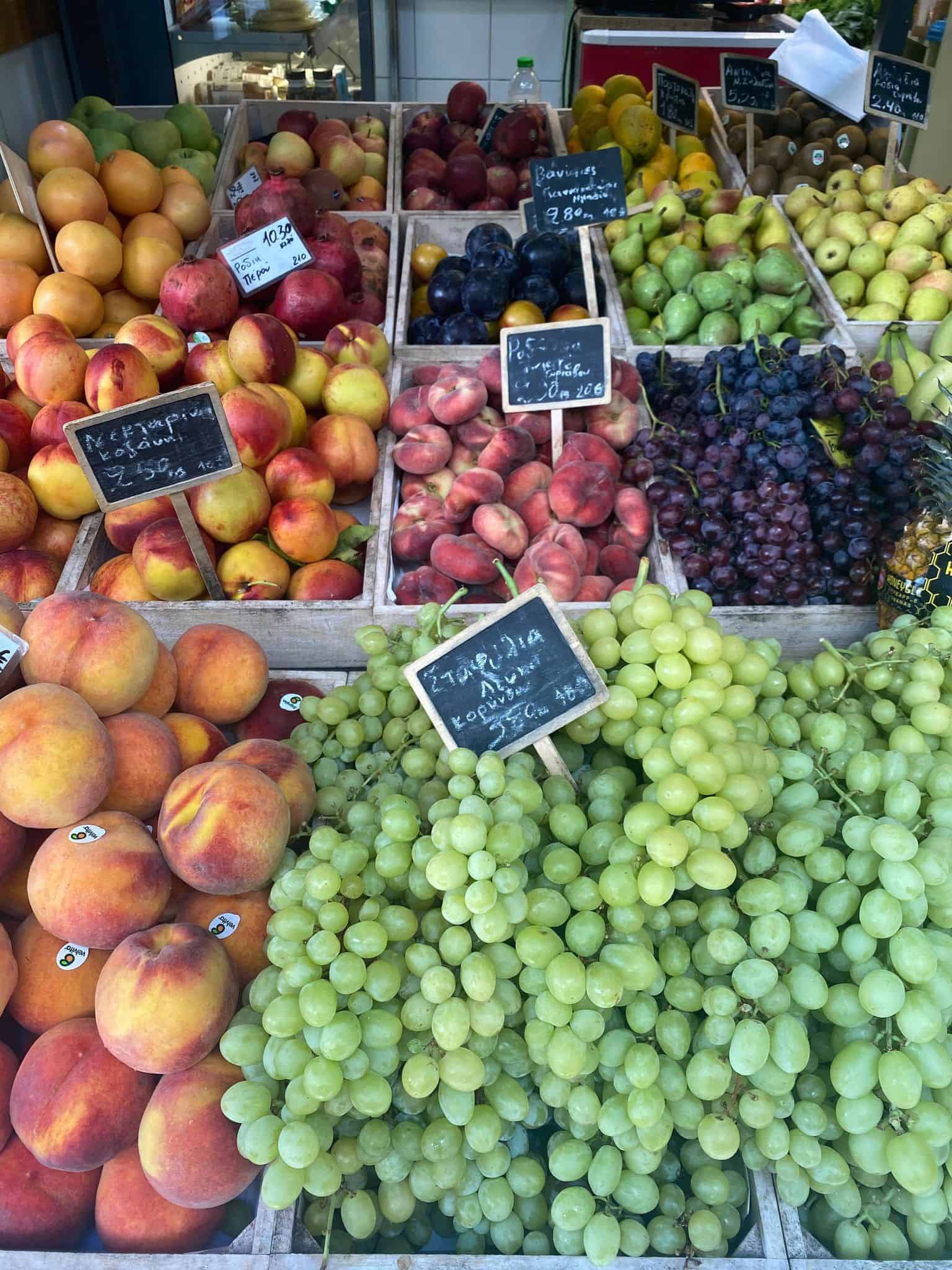
The above list provides you with lots of food for thought when it comes to thinking about what you can order during your trip to Greece. However, there are also several things that you can do to make your dining experiences in the country easier.
Download Vegan Eating Apps
The world-renowned Happy Cow app works in Greece and is worth downloading. It is a useful directory for understanding what restaurants are specifically vegetarian and vegan, and which places serve vegetarian/vegan-friendly dishes.
The Vegan Guide Greece App is also useful. Similarly, you can use TripAdvisor to scour through restaurants at the places you visit in Greece and see which establishments are detailed as serving vegan dishes.
Check Out the Local Farmer’s Markets in Greece
You will find weekly farmer’s markets (laiki) all over Greece. In large cities such as Thessaloniki and Athens, each neighbourhood hosts its own farmer’s market.
This is a great place to pick up fresh fruits and vegetables as well as other goodies like homemade jams and marmalades. If you are staying in self-catered accommodation, ask your host/reception where your local laiki is.
Eat at a Mageirio
Mageirios are great places to be aware of during your trip to Athens and beyond. These are low-cost dining places that could be compared to canteens.
Ready-made home-cooked meals sit out beneath a display, and the dishes prepared vary daily. You will find a lot of these places in more offbeat residential districts e.g. Pagrati in Athens, etc.
Mageirios also often offer delivery via Greek food apps such as Efood and Wolt. They are a good place to eat vegan food in Greece.
Additionally, stopping by a mageirio, whether to dine in or takeaway, offers a more authentic Greek experience. Local men often come by here after work instead of cooking for themselves. Few tourists have ever even heard of a mageirio.
Opt for Dedicated Vegan Restaurants
Several excellent vegan and vegetarian restaurants have emerged in Greece in recent years. Of course, these are among the best places to eat vegan food in Greece.
Some popular vegetarian and vegan restaurants, such as ROOTS in Thessaloniki, and Avocado in Athens, focus on international dishes. For instance, vegetarian Thai curries, or vegan burgers.
However, you don’t come to Greece to eat vegetarian Thai curry. Rest assured, many vegetarian and vegan spots serve meat-free versions of popular dishes like pastitsio and moussaka.
Choose Mezedopoleio Places
Look out for mezedopoleio places. These are traditional taverna-style restaurants that specialise in “small plates”.
Greek meze is kind of like Spanish tapas. You can order lots of little dishes to share with your dining companions and they only cost a few euros each. The best thing is that a lot of them are vegetarian and vegan!
Classic Greek tavernas will have popular vegetarian and vegan dishes. However, the menus tend to focus on either meat or seafood.
Sometimes the atmosphere is very smoky and you can see meat being prepared on a spit. As such, it’s probably not the kind of place that you want to dine in.
Similarly, you may have an ethical qualm about dining at restaurants where meat is prepared and that is also understandable. Thessaloniki is quite the gourmand and boasts ample restaurants that are decidedly vegan and vegetarian.
More and more dedicated vegan restaurants have begun to open in Athens in recent years.
Make a Note of these Vegan Restaurants
A selection of reputable vegetarian/vegan restaurants in Athens and Thessaloniki are detailed below.
Vegetarian & Vegan Restaurants in Athens
- ROOTS Food and Culture (Kapodistriou 2)
- Veganaki (Athanasiou Diakou 38)
- Vegan Beat Athens (Perikleous 56)
- Lime Bistro (Dekeleon 23)
- Mama Tierra (Akadimias 84)
- Avocado Athens (Nikis 30)
- Peas (Falirou 40)
- The Others (Kleisovis 4)
- Mystic Vegan (Emmanouil Benaki 76)
Vegetarian & Vegan Restaurants in Thessaloniki
- Elephant in the Room (Georgiou Papandreou 11)
- OMG in SKG (Episkopou Kitrous Nikolaou 1)
- Falafeleria (Martiou 14)
- Roots Vegan & Vegetarian Place (Mpalanou 4)
- Tarantula (Arrian 16)
Parting Words
As this article demonstrates, you will have quite a few delicious food options here in Greece if you are vegetarian or vegan. Another thing to love about Greece is the freshness of the ingredients.
All of the fruits and veggies here are locally grown and sourced. There are also a lot of Greek restaurants that adopt the “farm to table” concept and grow their own veggies in their own backyard.
There is a remarkable difference in the taste and texture of vegetables that are locally sourced and not imported. Even simple salads taste better in the Mediterranean!
If you have any more questions about vegan food in Greece, feel free to drop me a comment below. I’ll do my best to get back to you as soon as I can.
Geia sou! Melissa xo
